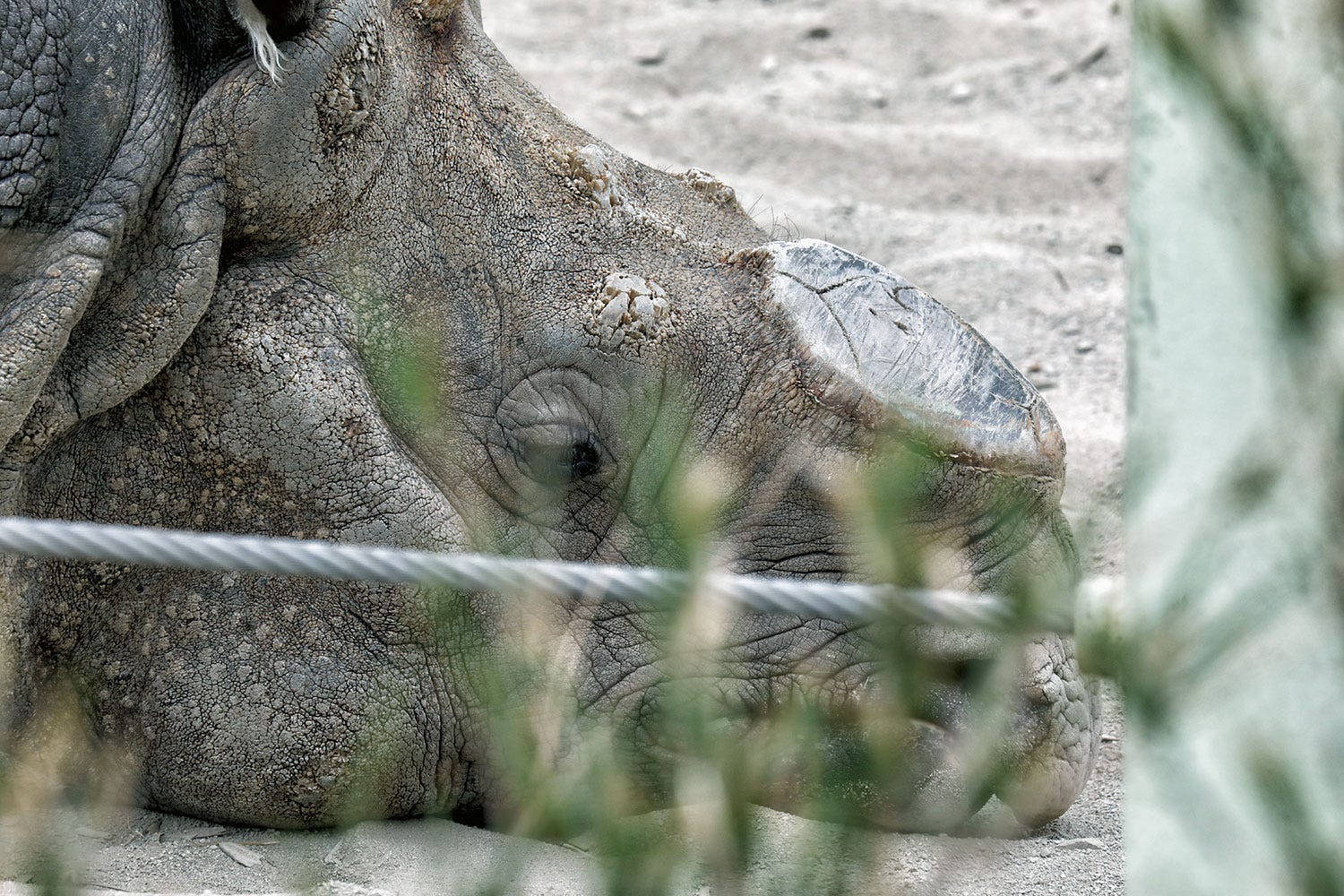Ghauhati Deserves Better: The Hidden Struggles of the SF Zoo’s Indian Rhino
Former Keeper Shares the Heartbreaking Stories of Ghauhati’s Life in a Century-Old Cage

At the center of the San Francisco Zoo stands a relic of outdated design—a century-old enclosure once meant for elephants but deemed unsuitable for them over twenty years ago. Made of towering metal bars and cold, echoing concrete, the space amplifies the voices and screams of zoo visitors, creating a chaotic, unnatural environment. The sandy ground, meant to mimic a natural landscape, does little to soften the stark, barren surroundings. Though the elephants were long ago removed, the exhibit remains, repurposed for another large species in a way that fails to meet their needs—just as it once failed the elephants.
Today, it is home to Ghauhati, an aging Indian rhino, whose life within these confines is a testament to the zoo’s ongoing neglect. His world is one of confinement rather than comfort, a space designed for captivity rather than care.
A Cage of Noise: The Unseen Torture of a Rhino’s Sensitive Hearing
While much of Ghauhati’s suffering is visible—the bars, the concrete, the lack of natural habitat—one of his greatest struggles is something visitors don’t see: the overwhelming assault on his sensitive hearing.
Rhinos have an exceptional ability to detect sound, often relying on subtle vibrations and low-frequency calls to communicate over long distances in the wild. But in his enclosure, sound behaves unnaturally, bouncing off concrete walls and metal bars, creating a constant barrage of amplified noise. Crowds of visitors, children shrieking, voices echoing—it all becomes an inescapable source of stress.
A former zookeeper who worked closely with Ghauhati recalled how the noise made his exhibit unbearable:
“The sounds of the people that visit the zoo—it’s a lot. He’s really sensitive to those sounds, and they just bounce around in that exhibit. It makes it a very uncomfortable space for him.”
This is why Ghauhati once chose to stay in his back holding area, behind the bars of what looks more like a prison cell than an animal habitat. There, he could escape the relentless noise—but at the cost of spending most of his time in an even smaller, isolated space off-exhibit.
However, SF Zoo Watch has received reports that zoo management has been forcing animals onto exhibit rather than giving them the choice to stay off-exhibit when they feel unsafe or stressed. If true, this would mean that Ghauhati, an animal already struggling with his environment, may be subjected to further distress, stripped of his last means of control over his own well-being.
A Life in the Wrong Exhibit
Ghauhati is a massive yet gentle creature, known for his intellegent and affectionate nature. Yet, his environment is a poor reflection of the wild, forested landscapes his species calls home.
Despite his intimidating size, Ghauhati is expressive, and deeply aware of his surroundings. “He’s very vocal,” one former caretaker said. “If he was left alone, he would make these calling sounds—it was like he was asking for attention.” He especially loved getting scratched, leaning into the touch. “Between the thick, armor-like folds of his skin, there were these incredibly soft spots—behind his ears, under his legs—places he loved to be scratched,” a former caretaker recalled. His bonds with keepers reveal the depth of his personality, but they also highlight how his needs as a highly sensitive animal are not being met.
Zoos claim to be educational institutions, places where visitors can observe animals behaving as they would in the wild. But for Ghauhati, those moments are rare. On quiet days, when the zoo is empty, he might feel comfortable enough to explore, wade in his shallow pool, or exhibit some fraction of his natural behaviors. But when crowds descend, the noise and activity overwhelm him, driving him into stress and retreat. “He was very uncomfortable in that exhibit,” the former keeper added.
This is the cost of keeping animals in spaces never meant for them. And it's a cost that extends beyond Ghauhati.
San Francisco Zoo: A Case Study in Mismanagement
Ghauhati’s story is not unique—it’s a reflection of a larger systemic failure in zoos that prioritize spectacle over welfare. Nowhere is this more evident than at the San Francisco Zoo, an institution long criticized for its outdated exhibits, poor animal welfare standards, and reluctance to invest in meaningful reform.
For years, SF Zoo has housed animals in spaces ill-suited to their needs. Its great apes remain confined in cramped, outdated enclosures that fail to offer the complexity and stimulation required for their intelligence. Most species are shuffled between exhibits never designed for them, forced to adapt to settings that fail to meet their physical and psychological needs.
Much like Ghauhati’s ill-fitting exhibit, SF Zoo has a troubling habit of repurposing old enclosures instead of building spaces designed with the animals’ needs in mind. The result? Animals housed in environments that stress rather than support them, enclosures built for past occupants rather than current ones. Instead of prioritizing the creation of species-appropriate habitats, the zoo leans on quick fixes—patchwork solutions that fail to address the root issue: a fundamental lack of commitment to animal well-being.
If SF Zoo truly wants to be an institution of conservation and education, it must move beyond temporary fixes and commit to real reform. That means investing in modern, expansive, species-appropriate enclosures, rethinking how animals are housed, and placing welfare above convenience. Because until that happens, SF Zoo—and institutions like it—will remain places of confinement, not care.
And animals like Ghauhati will continue to suffer the consequences.
